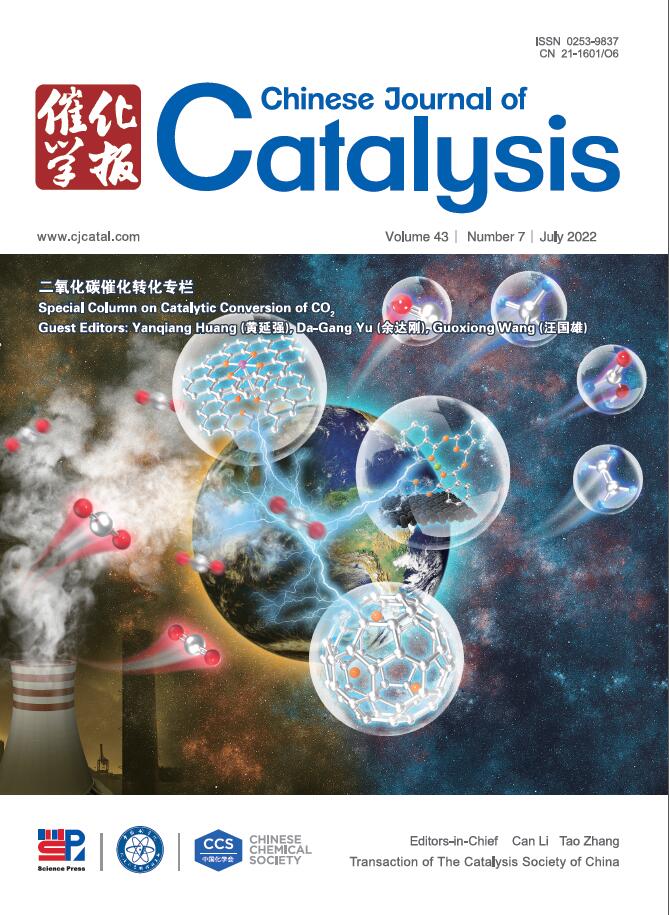以Ni单原子/P、n掺杂的无定形NiFe2O4为阳极催化剂,Ag NPs@CuO/Cu2O纳米立方为阴极催化剂组成的高效光电化学电池,用于微塑性氧化和CO2还原
IF 17.7
1区 化学
Q1 CHEMISTRY, APPLIED
引用次数: 0
摘要
塑料在人类生活中无处不在,对环境和人体造成一定危害。大气中二氧化碳含量的增加将导致温室效应。因此,利用环保高效的技术处理微塑料废物和二氧化碳已迫在眉睫。在这项工作中,我们开发了一种高效的光电催化体系,该体系由P, n掺杂的非晶态NiFe2O4 (Ni SAs/A-P-N-NFO)作为阳极,由CuO/Cu2O纳米立方体(Ag NPs@CuO/Cu2O NCs)作为阴极组成,用于微塑性氧化和CO2还原。采用煅烧- h2还原法制备了Ni SAs/ a - p - n- nfo,在AM 1.5 G光下,对聚对苯二甲酸乙酯(PET)溶液进行氧化反应的法拉第效率达到93%。合成的Ag NPs@CuO/Cu2O NCs作为光电阴极,在1.5 V / RHE条件下将CO2还原为乙烯和CO,选择性分别为42%和55%。这项工作表明,光电催化作为一种环境友好型技术,是减少轻塑料对环境和生物危害以及有效减少二氧化碳的可行策略。本文章由计算机程序翻译,如有差异,请以英文原文为准。
Efficient photoelectrochemical cell composed of Ni single atoms/P, N-doped amorphous NiFe2O4 as anode catalyst and Ag NPs@CuO/Cu2O nanocubes as cathode catalyst for microplastic oxidation and CO2 reduction
Plastics are ubiquitous in human life and pose certain hazards to the environment and human body. The increasing amount of CO2 in the atmosphere will lead to the greenhouse effect. Therefore, it is urgent to treat microplastic waste and CO2 by using environmentally friendly and efficient technologies. In this work, we developed an efficient photoelectrocatalytic system composed of Ni single atoms (Ni SAs) supported by P, N-doped amorphous NiFe2O4 (Ni SAs/A-P-N-NFO) as anode and Ag nanoparticles (Ag NPs) supported by CuO/Cu2O nanocubes (Ag NPs@CuO/Cu2O NCs) as cathode for microplastic oxidation and CO2 reduction. The Ni SAs/A-P-N-NFO was synthesized by calcination-H2 reduction method, and it achieved a Faraday efficiency of 93% for the oxidation reaction of poly (ethylene terephthalate) (PET) solution under AM 1.5 G light. As a photocathode, the synthesized Ag NPs@CuO/Cu2O NCs was utilized to reduce CO2 to ethylene and CO at 1.5 V vs. RHE with selectivity of 42% and 55%, respectively. This work shows that the photoelectrocatalysis, as an environmentally friendly technology, is a feasible strategy for reducing the environmental and biological hazards of light plastics, as well as for efficient CO2 reduction.
求助全文
通过发布文献求助,成功后即可免费获取论文全文。
去求助
来源期刊

Chinese Journal of Catalysis
工程技术-工程:化工
CiteScore
25.80
自引率
10.30%
发文量
235
审稿时长
1.2 months
期刊介绍:
The journal covers a broad scope, encompassing new trends in catalysis for applications in energy production, environmental protection, and the preparation of materials, petroleum chemicals, and fine chemicals. It explores the scientific foundation for preparing and activating catalysts of commercial interest, emphasizing representative models.The focus includes spectroscopic methods for structural characterization, especially in situ techniques, as well as new theoretical methods with practical impact in catalysis and catalytic reactions.The journal delves into the relationship between homogeneous and heterogeneous catalysis and includes theoretical studies on the structure and reactivity of catalysts.Additionally, contributions on photocatalysis, biocatalysis, surface science, and catalysis-related chemical kinetics are welcomed.
 求助内容:
求助内容: 应助结果提醒方式:
应助结果提醒方式:


